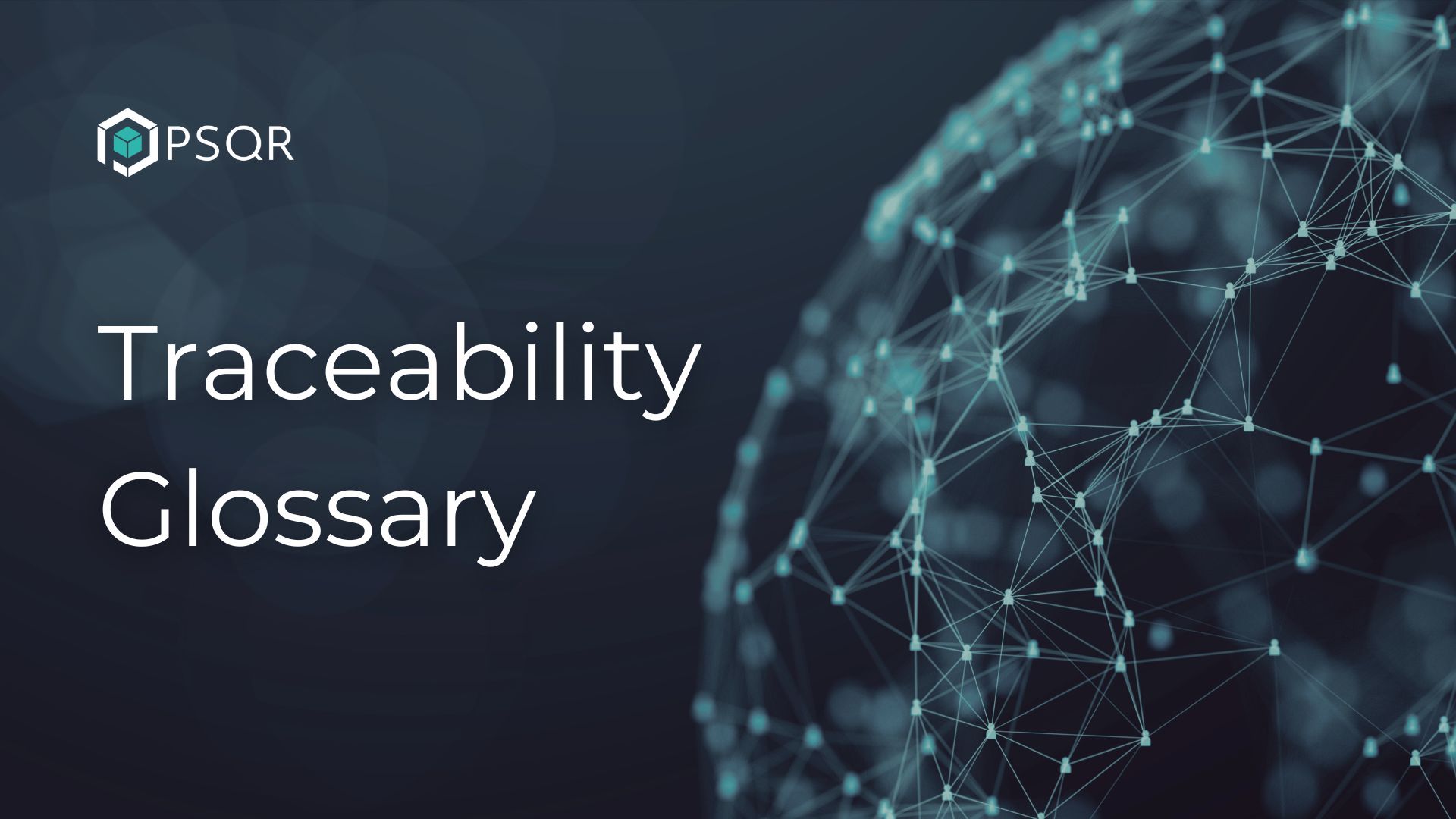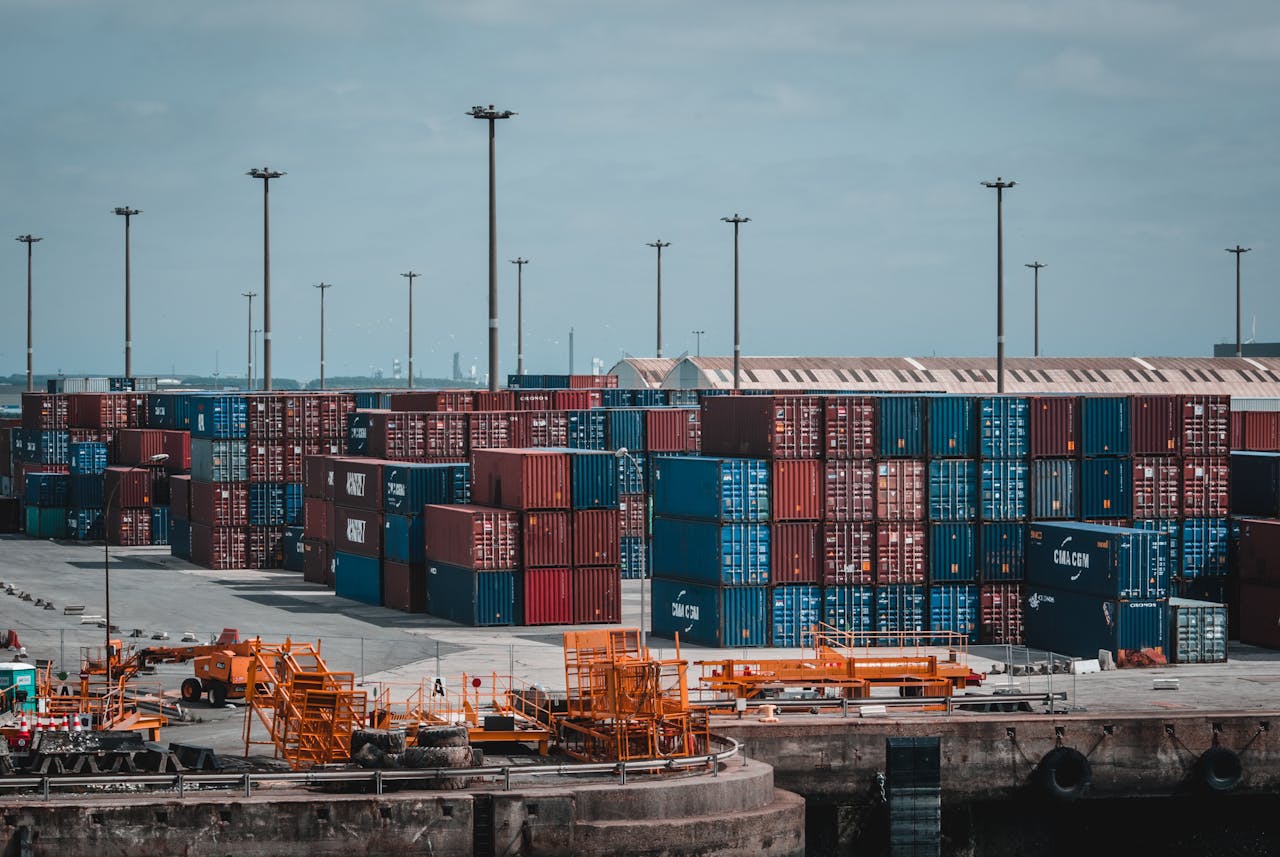A
Aggregation – The process of combining discrete units or batches.
Application Identifier (AI) – An Application Identifier is a number at the beginning of a data string that identifies the intended interpretation of the following data. It also determines the size of the data.
API – Application Programming Interface (API) is a set of definitions and protocols to build and integrate application software.
Audit Trail – A chronological record of activities, transactions, and changes in the supply chain, providing transparency and accountability for traceability purposes.
Automatic Identification and Data Capture (AIDC) – A technology that captures data automatically. AIDC technologies include barcodes, smart cards, biometrics, and radio frequency identification devices.
B
Barcode – A visual representation of data readable by a barcode scanner, used to identify and track products in the supply chain.
Batch (aka lot) – Individual products are often produced simultaneously in a process (as a batch) rather than individually. A batch number helps a manufacturer identify when, where, and how products were produced.
Batch-level or Lot-level data – Granular information about a defined quantity of a material or product that is processed together.
Batch Traceability – Ability to track information about a group of products (batch) with similar attributes.
Bill of Lading – A document detailing a product shipment’s type, quantity, and destination. The bill of lading is a contract between the shipping party and the transporter. It also serves as a receipt of shipment when the shipment is delivered to the receiving party.
Bill of Material (BOM) – A list of the raw materials and components, plus the quantities needed to manufacture a product.
C
Catch Documentation and Traceability (CDT) – Catch Documentation and Traceability (CDT) is the practice of documenting key information about the harvest, processing, and transportation of a fisheries product to enable traceability of the seafood product back through each step of its journey – from its import or point of final sale back to its harvest and point of origin.
Certificate – A document certifying that one has fulfilled the requirements of and may practice in a field.
Certificate of Origin (aka declaration of origin) – A document widely used in international trade transactions which attests that the product listed therein has met certain criteria to be considered as originating in a particular country.
Certificate of Scope – Companies that have demonstrated the ability to comply with the relevant standard requirements by an approved certification body (CB) will be issued a scope certificate (SC). The SC means that the company is eligible to process the certified products on its list. This does not automatically mean the product you are ordering is certified unless there is a transaction certificate (TC) to accompany it.
Certificate of Transaction – Transaction Certificate (TC) is a document issued by the Certification Body that verifies the goods being shipped (or delivered) from one organization to the next conform to a given standard.
Centralized Database – A centralized database is basically a type of database that is stored, located, and maintained at a single location only. This type of database is modified and managed from that location itself. This location is thus mainly any database system or a centralized computer system.
Chain of Custody – This is the sequence of ownership as a product moves through a supply chain. The precision that the material is tracked through a supply chain is defined by various chain of custody models, such as certificate trading, identity preservation, mass balance, and certification.
Circular Business Models – Circular businesses are deeply involved in the product usage phase. Instead of selling physical products, they generate revenue by providing services. This often means rethinking traditional producer-consumer relationships, value creation activities, and value chain structure. Environmental and social impact benefits then complement the overall business culture and philosophy.
Circular Economy – Opposed to a linear economy where materials are extracted, used and disposed of, a circular economy keeps materials in continuous use. These loops reduce process inefficiency and prevent material from leaving systems in the form of waste or pollution.
Cold Chain – A supply chain that maintains products at or below a particular temperature through refrigerated storage and transport.
Compliance – Adhering to requirements that are decreed by laws and regulations.
Corporate Social Responsibility (CSR) – The commitment of firms to incorporate environmental, social, and governance responsibilities into their businesses and supply chains.
Critical Control Point (CCP) – A point or step within the food-production process (from raw material to finished product) at which control can be applied to prevent, eliminate, or reduce (to an acceptable level) a food safety hazard.
Critical Tracking Event (CTE) – A specific point a long supply chain where certain key data elements need to be captured to enable the traceability of a product. CTEs can include harvest, landing, primary processing, aggregation, packaging, shipping, receiving, and sale.
CRUD – CRUD is an acronym from the world of computer programming and refers to the four functions considered necessary to implement a persistent storage application: create, read, update, and delete.
D
Data Architecture – Data architecture comprises models, policies, rules, or standards that govern how data is stored, managed, and utilized in an information system.
Data Capture – The process of collecting and recording relevant data points associated with the movement and handling of products within the supply chain.
Data Carriers – Labels or tags containing data that are physically attached to a unit to pair data with a product. Data carriers can be machine-readable, such as barcodes and RFID tags, or may be human-readable, such as standard labels or both, such as hybrid labels.
Data Governance – The development, execution, and supervision of policies, programs, and practices that standardize, collect, control, protect, deliver, and enhance the value of data and information assets.
Data Synchronization – Maintaining the consistency and uniformity of data instances across all consuming applications and storage devices.
Data Verification – The capacity to cross-check product or company-level information at any point in the supply chain with data supplied by other stakeholders or vetted by third parties. Data verification is critical for proving the legitimacy of the data and for preventing what might develop as traceability fraud.
Decentralized Data – The process of attaching data to a product, rather than the product owner, using blockchain technology.
Digital Product Passport (DPP) – A virtual record associated with an individual product, often providing information about the product’s origins and environmental impact. These are designed to inform consumers about the broader impact of their purchasing decisions and make it easier for materials to be repurposed once a product reaches the end of its life.
Digital Transformation – The term describes adopting digital technologies to improve existing efficiencies and outputs of any organisation’s current workflows, production processes, and communications. This is often by replacing legacy non-digital methods.
Digital Twin – A Digital Twin is essentially virtualization technology and enables transparency and tracking at every point of the product lifecycle.
Digitization – The process of converting, streamlining and converging analogue information from emails, PDFs and Excel spreadsheets into a digital format on a unified system.
Disclosure – The sharing of information by a corporation that informs its stakeholders about its actions to enable equal access to facts about the company. This might take the shape of press releases, sustainability reports, or other media.
Due Diligence – Auditing your supply chain to identify, mitigate, and account for potential environmental and social issues.
E
Electronic Traceability – The ability to trace the history, application or location of an entity by means of recorded identifications.
End-of-Life (EoL) Processing – This is the final stage of a product’s existence in manufacturing and product life cycles. EoL processing involves the reuse, repurposing, or recycling of the components in a product.
Environmental, Social, and Corporate Governance (ESG) – A measurement companies use to evaluate how their operations impact three core pillars of sustainability.
EPCIS Standard – GS1 Electronic Product Code Information Services (EPCIS) is an open standard that allows businesses to capture and share supply chain information about the movement and status of goods within their enterprise and with their business partners.
EPC – The Electronic Product Code (EPC) is designed as a universal identifier (using an idiosyncratic numerical code for each different commodity) that provides a unique identity for every physical object anywhere in the world, for all time.
ERP System – Enterprise Resource Planning (ERP) refers to a type of software that organizations use to manage day-to-day business activities such as accounting, procurement, project management, risk management and compliance, and supply chain operations.
Evidence Request – The process of contacting suppliers, either digitally or manually, to ask for information about their operations about a specific risk area.
F
Fiber Forward Traceability – Refers to the bottom-up process of tracing a product from the raw material phase to the end product in real time.
Fishery Information System (FIS) – A general term used to describe an electronic data system to collect, manage, and share fisheries information for various uses.
Food Safety Modernization Act (FSMA) – The Food Safety Modernization Act was signed into law in 2011 and enables the Food and Drug Administration (FDA) to better protect public health by strengthening food safety from farm to table.
FNC1 – Every GS1-128 barcode begins with the (FNC1) “Function Code One” character and an Application Identifier (AI) number. The AI defines a specific purpose for the data field after it. The combination of the AI and its data field is called the element string.
Fragmentation – This refers to data broken up into different formats or across different platforms, leading to inefficiencies and inaccuracies.
G
GDST – The Global Dialogue on Seafood Traceability (GDST) is an international, business-to-business platform established to advance a unified framework for interoperable seafood traceability practices.
Global Location Number (GLN) – The GS1 identification key is used to identify physical locations or parties. The key comprises a GS1 Company Prefix, location reference, and check digit.
Global Trade Item Number® (GTIN®) – The GS1 identification key used to identify trade items. The key comprises a GS1 Company Prefix, an item reference, and a check digit.
GS1 – A neutral, not-for-profit, global organization that develops and maintains the world’s most widely used supply chain standards.
GS1-128 Linear Barcode – A barcode symbology using bars and spaces in one dimension that leverages a subset of Code 128 used exclusively for GS1 system data structures.
GS1 Application Identifier – The field of two or more digits at the beginning of an element string that uniquely defines its format and meaning.
GS1 Company Prefix – A globally unique string of four to twelve digits assigned to an entity and used to issue GS1 identification keys. The first digits are a valid GS1 prefix, and the length must be at least one longer than the length of the GS1 prefix. A GS1 Member Organization issues the GS1 Company Prefix. As the GS1 Company Prefix varies in length, issuing a GS1 Company Prefix excludes all longer strings that start with the same digits from being issued as GS1 Company Prefixes.
GS1 DataMatrix – GS1 implementation specification for the use of the DataMatrix.
GS1 Healthcare – A global, voluntary user group that develops standards to advance global harmonization. GS1 Healthcare comprises manufacturers, wholesalers, distributors, hospitals, and pharmacy retailers and maintains close contacts with regulatory agencies and trade organizations worldwide. It drives the development of GS1 standards and solutions to meet the needs of the global healthcare industry and promotes the effective use and implementation of global standards for the industry.
H
Hard Technology – Refers to asset-intensive, physical, science-based technology, including innovations that integrate into existing production systems.
I
Integrated Hardware Traceability – Includes bar codes, readers, RFID tags, and scanners to record information related to products for traceability purposes. Integrated systems typically dovetail with a company’s computer systems, such as financial, information technology, and inventory management systems.
Internal Traceability – A company’s ability to track and preserve information about individual batches or units as they move through its facility. The tracking and data preservation must exist throughout all internal processes, such as when a batch or unit is aggregated, disaggregated, transformed, transported or otherwise altered.
Interoperability – The ability of different systems, devices, applications or products to connect and communicate in a coordinated way without effort from the end user.
Inventory – Physical amount of products on hand and available for sale.
IIoT – The Industrial Internet of Things (IIoT) is a network of connected devices in the industrial sector. It is a subset of the Internet of Things IoT. The defining characteristic of connected devices on IIoT networks is that they transfer data without human-to-human or human-to-computer interaction.
IoT – The Internet of Things (IoT) describes the network of physical objects – “things” – that are embedded with sensors, software, and other technologies to connect and exchange data with other devices and systems over the Internet.
ISO – International Organization for Standardization (ISO) is an independent, non-governmental, international organization that develops standards to ensure the quality, safety, and efficiency of products, services, and systems.
K
KDE – Key Data Element – Key Data Element (KDE) also referred to as Critical Data Element (CDE) can be defined as elements with material impact on your organization’s business operations, decisions, and other data demands i.e regulartory, compliance, and market demands.
L
Life Cycle Assessment (LCA) – A methodology for assessing environmental impacts associated with all the stages of a product’s life, from manufacturing to disposal.
Legislation – Laws and regulations made by a government that businesses must adhere to.
Logistics – A management process of coordinating and moving resources – people, materials, inventory, and equipment – from one location to storage at the desired destination.
M
Material-based Claims – This refers to any declaration made by a business relating to the materials used to manufacture their products.
Materiality Assessment – A type of stakeholder engagement designed to obtain insight into the relevance of specific environmental, social, and governance (ESG) problems. The knowledge is most typically used to guide sustainability reporting and communication initiatives, but it is also helpful in strategic planning, operational management, and capital investment choices.
Medical Device – Any instrument, apparatus, implement, machine, appliance, implant, in vitro reagent or calibrator, software, material, or other similar or related article, intended by the manufacturer to be used, alone or in combination, for human beings for any medical purpose.
Manufacturer – An entity that makes or produces drugs, pharmaceuticals, or medical devices through a process involving raw materials, components, or assemblies, usually on a large scale.
N
Node – A distinct entity in a supply chain that may be responsible for capturing, inputting, storing, or sharing data.
P
Product – An object with a defined set of attributes or characteristics.
Product Backward Traceability – Otherwise known as top-down traceability, this refers to tracking a product’s supply chain after manufacturing.
Product Identification – The linking of a physical product throughout a firm’s operations, including when the product is disaggregated or transformed. Standard practices include barcodes, QR codes, physical stamps, and labels.
Product Lifecycle Management (PLM) – Organizations use this to develop new products and track and share data throughout the supply chain.
Procurement – The process of purchasing goods or services and is usually about business spending.
Purchase Order (PO) – This document issued by a brand to a supplier indicates the styles, quantities, and prices for products they have purchased.
Q
QR Code – A QR code (quick response code) is a type of two-dimensional (2D) bar code that is used to provide easy access to online information through the digital camera on a smartphone or tablet.
R
Real-time Data – Refers to when information is collected about a material or product; in this case, it is recorded as the item moves through the value chain.
Recall – Recall or Product recall is the process of retrieving and replacing defective or unsafe consumer goods.
Regulatory Due Diligence – A comprehensive assessment of compliance with existing regulations related to social and environmental concerns.
Reporting – The collection and presentation of information about practices to a reporting organization which ensures compliance.
Responsible Sourcing – Implementing ethical, environmental, and socially conscious concepts into sourcing, procurement, and overall supply chain management procedures. This method assures that a buyer’s and its suppliers’ business is handled in a way that does not harm society or the environment.
RFID – Radio Frequency Identification (RFID) refers to a wireless system comprised of two components: tags and readers. The reader is a device with one or more antennas that emit radio waves and receive signals from the RFID tag.
S
Scope 1 Emissions – Direct emissions from owned or controlled sources.
Scope 2 Emissions – Indirect emissions from the generation of purchased energy.
Scope 3 Emissions – All indirect emissions (not included in scope 2) that occur in the value chain of the reporting company, including both upstream and downstream emissions. This includes the impact of raw material extraction, material processing, all other transportation, distribution, product use impact, waste production, and end-of-life processing.
SDG – Sustainable Development Goals (SDG) were set up in 2015 by the United Nations General Assembly (UN-GA) comprising a “blueprint to achieve a better an more sustainable future for all”. It includes 17 interlinked goals to be achieved by 2030, comprising the global challenges we face today, such as poverty, hunger, good health, quality education, gender equality, clean water, clean energy, economic growth, etc.
Self-sovereign Identity (SSI) – A means of demonstrating the unique identity of a person or entity using digital technologies to provide an individual with control of their identity. This system allows two parties to verify each other’s identities without having to share specific identity documents with each other. Validation is instead provided by an external third party (usually via a decentralized blockchain).
Serial Number – A unique identifier assigned to an individual product or component that enables its traceability throughout the supply chain.
Serial Shipping Container Code (SSCC) – The GS1 identification key used to identify logistic units. The key comprises an extension digit, GS1 Company Prefix, serial reference, and check digit.
Soft Technology – This refers to digital B2C solutions like rental and resale platforms and B2B solutions like traceability software.
SQL – Structured Query Language (SQL) is a standardized programming language that is used to manage relational databases and perform various operations on the data in them.
Standardized Data – This refers to the process of establishing common identifiers so that multiple systems auditing different or overlapping issues can exchange and collate information.
Supplier – An entity with which a procurement agent has a contractual relationship for providing one or more trade items. The supplier is involved or plays a role in the buying, selling, or production of the pharmaceutical or medical device and can be a manufacturer, brand owner, wholesaler, or distributor.
Supply Chain – Series of parties that conduct processes or activities to produce and distribute material or product.
Supply Chain Management (SCM) – Managing the flow of goods and services through a business to optimize quality, on-time delivery, and profitability.
Supply Chain Traceability – The ability to track and trace the movement of products or components throughout the supply chain, from raw materials to the end consumer.
Supply Chain Transparency – Transparency relates to the degree to which information on processes, procedures, material, and product information is disclosed in a clear, factual, neutral, and understandable manner (i.e., an audit trail).
Supply Chain Visibility – The ability to know information about the companies supplying products – specifically where they are located, what they do, how they do it, and whether their licenses and practices fall within legal limits. The focus of supply chain visibility is at the company or facility level, not at the product level.
T
Third-party Audits – Independent groups that perform on-the-ground assessments of facilities to ensure that they’re working in compliance with certifications.
Third-party Verification – Using an outside party to check internal claims regarding sustainability progress for public disclosure.
Tier – Supply chains are commonly divided into tiers where different functions are performed to transform raw material into a finished product.
Tobacco Products Directive (TPD) – The Tobacco Products Directive aims to improve the functioning of the internal market for tobacco and related products while ensuring a high level of health protection for European citizens.
Traceability – The ability to trace the history, application, or location of a material or product through recorded identifications.
Traceability Provider – A business or organization that offers software or hardware designed to fulfil one or more of the five core business functions of traceability.
Traceability System – The method to record traceability data for products and raw materials.
Track and Trace – The process of monitoring and recording the past and present whereabouts of a shipment as it passes through a network through different handlers on its way to its destination. Tracing refers to where the product has been, while tracking refers to where it is going.
Transformation – Any change made to a traceable item (such as a batch or individual item) that affects its identity or characteristics. The transformation includes aggregation, disaggregation, processing, value-added activities, packing, and repacking traceable items.
Transparency – A principle of information sharing between companies and stakeholders to clearly understand the company’s activities, including its environmental and social impacts.
Triple Bottom Line (TBL) – A framework that evaluates a company’s performance in terms of environmental, social, and economic impact.
U
Unique Identifier – A code or number that uniquely identifies a specific item, enabling its differentiation from other items.
UUID – A Universal Unique Identifier (UUID) is a 128-bit value used to identify an object or entity on the internet uniquely.
V
Verification – Ensuring that a claim, assertion, or statement is true, accurate, or compliant with relevant standards, regulations, or requirements.
Virtualization – Creating a virtual version of something, such as a device or resource.
Download the Traceability Glossary by clicking on the image below.






